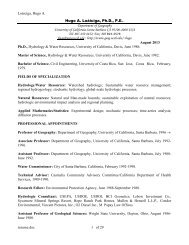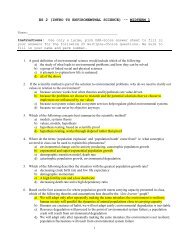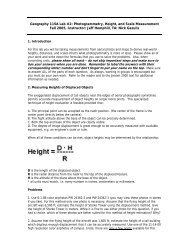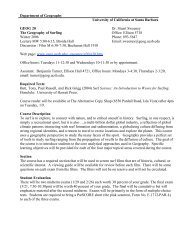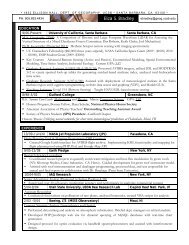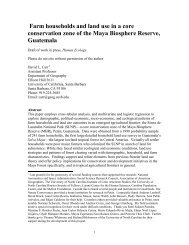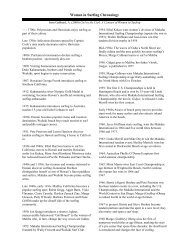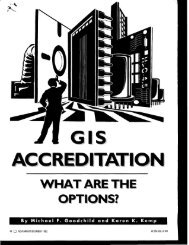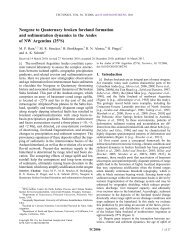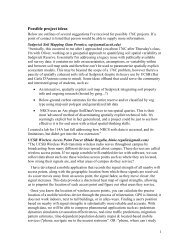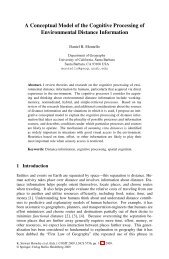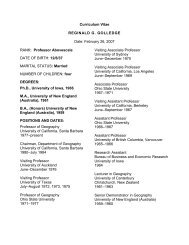Spatial knowledge acquisition from direct experience in the ...
Spatial knowledge acquisition from direct experience in the ...
Spatial knowledge acquisition from direct experience in the ...
You also want an ePaper? Increase the reach of your titles
YUMPU automatically turns print PDFs into web optimized ePapers that Google loves.
98 T. Ishikawa, D.R. Montello / Cognitive Psychology 52 (2006) 93–129<br />
pattern of people’s spatial <strong>knowledge</strong>, which is quite unusual <strong>in</strong> <strong>the</strong> literature on spatial<br />
microgenesis.<br />
1.5. Objectives of this research<br />
Except for <strong>the</strong> few attempts discussed above, microgenetic development of spatial<br />
<strong>knowledge</strong> has not been <strong>in</strong>vestigated much <strong>in</strong> controlled longitud<strong>in</strong>al studies. As we discussed<br />
above, <strong>the</strong> dom<strong>in</strong>ant framework, explicitly proposed 30 years ago, has strongly<br />
<strong>in</strong>Xuenced spatial cognition research <strong>in</strong> several discipl<strong>in</strong>es; even if not cited by name, its<br />
concepts of nonspatial landmark <strong>knowledge</strong> and, especially, nonmetric and sequential<br />
route <strong>knowledge</strong> still echo through <strong>the</strong> writ<strong>in</strong>gs of various cognitive-science Welds (as we<br />
cited above). This is true even though it has never received clear empirical support. Likewise,<br />
critiques of <strong>the</strong> dom<strong>in</strong>ant framework and <strong>the</strong> ideas suggested as alternatives have not<br />
had much empirical research speciWcally <strong>direct</strong>ed at <strong>the</strong>m. In our research, <strong>the</strong>refore, we<br />
aim to <strong>in</strong>vestigate how people’s spatial <strong>knowledge</strong> of <strong>the</strong> environment, particularly <strong>the</strong><br />
accuracy and precision of <strong>the</strong>ir <strong>knowledge</strong>, develops over time.<br />
We are speciWcally motivated by three major research questions. Our Wrst question concerns<br />
<strong>the</strong> development of metric <strong>knowledge</strong> (distances and <strong>direct</strong>ions) <strong>in</strong> a new environment<br />
learned <strong>direct</strong>ly via locomotion. In particular, we look at <strong>the</strong> level of people’s<br />
conWgurational understand<strong>in</strong>g of routes (i.e., beyond <strong>the</strong> sequential, nonmetric route<br />
<strong>knowledge</strong> of <strong>the</strong> dom<strong>in</strong>ant framework’s term<strong>in</strong>ology). Our second question concerns people’s<br />
ability to <strong>in</strong>tegrate separately learned places <strong>in</strong>to a common frame of reference (i.e.,<br />
<strong>the</strong> <strong>acquisition</strong> of <strong>in</strong>tegrated survey <strong>knowledge</strong>). Related to this question, we also look at<br />
whe<strong>the</strong>r people acquire spatial <strong>knowledge</strong> diVerently when <strong>the</strong>y travel a route <strong>in</strong> two opposite<br />
<strong>direct</strong>ions, compared to when <strong>the</strong>y travel a route <strong>in</strong> only one <strong>direct</strong>ion. Our third major<br />
question concerns <strong>in</strong>dividual diVerences <strong>in</strong> people’s spatial <strong>knowledge</strong>; speciWcally, how<br />
diVerent <strong>in</strong>dividuals’ developmental curves look with respect to accuracy and a developmental<br />
pattern, and whe<strong>the</strong>r <strong>the</strong> diVerence is especially large for <strong>in</strong>tegration.<br />
To <strong>in</strong>vestigate <strong>the</strong>se questions, we conducted a longitud<strong>in</strong>al experiment <strong>in</strong> a naturalistic<br />
sett<strong>in</strong>g, with as much experimental control as possible concern<strong>in</strong>g <strong>the</strong> amount and method of<br />
exposure to <strong>the</strong> environment. We exam<strong>in</strong>ed participants’ performance on tasks that assessed<br />
<strong>the</strong>ir spatial <strong>knowledge</strong>, both metric and nonmetric, once a week for 10 consecutive weeks.<br />
1.6. Predictions of <strong>the</strong> dom<strong>in</strong>ant and cont<strong>in</strong>uous frameworks<br />
If spatial microgenesis progresses through qualitatively dist<strong>in</strong>ct stages as conceived by<br />
<strong>the</strong> dom<strong>in</strong>ant framework, participants’ performance on metric tasks should be at or near<br />
chance level <strong>in</strong> early sessions. Only after repeated sessions, participants’ performance<br />
should become better than chance and beg<strong>in</strong> to improve. On <strong>the</strong> o<strong>the</strong>r hand, if spatial<br />
microgenesis is cont<strong>in</strong>uous, as <strong>the</strong> cont<strong>in</strong>uous framework argues, participants’ performance<br />
should be at least better than chance <strong>from</strong> <strong>the</strong> Wrst session and gradually improve.<br />
Both <strong>the</strong> dom<strong>in</strong>ant and cont<strong>in</strong>uous frameworks agree that <strong>the</strong> <strong>acquisition</strong> of <strong>in</strong>tegrated<br />
conWgurational <strong>knowledge</strong> (or survey <strong>knowledge</strong>) is a large, sophisticated step <strong>in</strong> microgenetic<br />
development. If so, people’s performance should be poor on between-route, as<br />
opposed to with<strong>in</strong>-route, tasks, at least <strong>in</strong> early sessions. Also, <strong>the</strong>ir performance should be<br />
aVected by <strong>the</strong> complexity of routes. Fig. 1 schematically illustrates <strong>the</strong> predicted patterns<br />
of development by <strong>the</strong> two frameworks.



